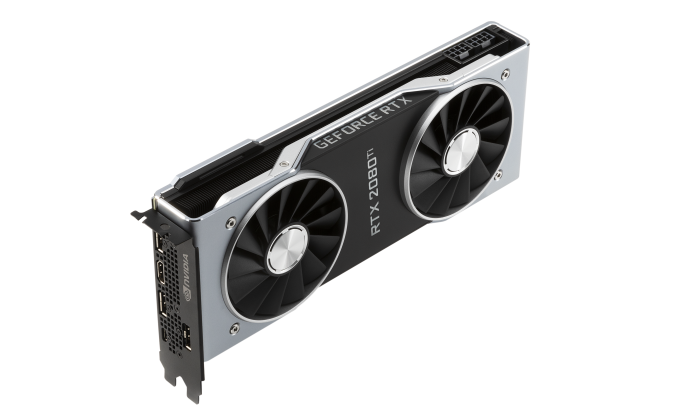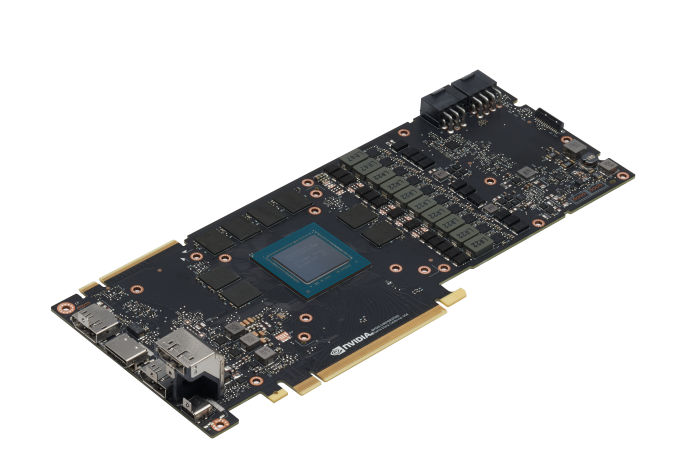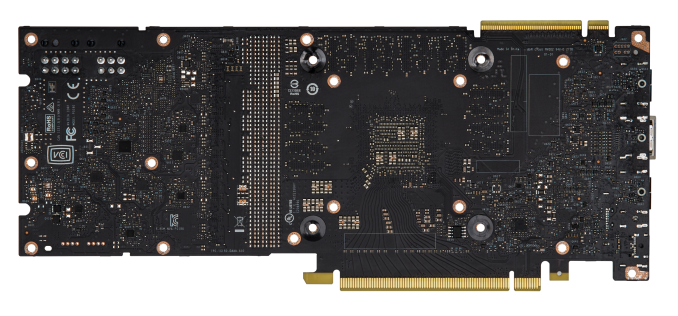The NVIDIA GeForce RTX 2080 Ti & RTX 2080 Founders Edition Review: Foundations For A Ray Traced Future
by Nate Oh on September 19, 2018 5:15 PM EST- Posted in
- GPUs
- Raytrace
- GeForce
- NVIDIA
- DirectX Raytracing
- Turing
- GeForce RTX
Meet The GeForce RTX 2080 Ti & RTX 2080 Founders Editions Cards
Moving onto the design of the cards, we've already mentioned the biggest change: a new open air cooler design. Along with the Founders Edition specification changes, the cards might be considered 'reference' in that they remain a first-party video card sold direct by NVIDIA, but strictly-speaking they are not because they no longer carry reference specifications.
Otherwise, NVIDIA's industrial design language prevails, and the RTX cards bring a sleek flattened aesthetic over the polygonal shroud of the 10 series. The silver shroud now encapsulates an integrated backplate, and in keeping with the presentation, the NVLink SLI connectors have a removable cover.
Internally, the dual 13-blade fans accompany a full-length vapor chamber and component baseplate, connected to a dual-slot aluminum finstack. Looking at improving efficiency and granular power control, the 260W RTX 2080 Ti Founders Edition features a 13-phase iMON DrMOS power subsystem with a dedicated 3-phase system for the 14 Gbps GDDR6, while the 225W RTX 2080 Founders Edition weighing in with 8-phases main and 2-phases memory.
As is typical with higher quality designs, NVIDIA is pushing overclocking, and for one that means a dual 8-pin PCIe power configuration for the 2080 Ti; on paper, this puts the maximum draw at 375W, though specifications-wise the TDP of the 2080 Ti Founders Edition against the 1080 Ti Founders Edition is only 10W higher. The RTX 2080 Founders Edition has the more drastic jump, however, with 8+6 pins and a 45W increase over the 1080's lone 8 pin and 180W TDP. Ultimately, it's a steady increase from the power-sipping GTX 980's 165W.
One of the more understated changes comes with the display outputs, which thanks to Turing's new display controller now features DisplayPort 1.4 and DSC support, the latter of which is part of the DP1.4 spec. The eye-catching addition is the VR-centric USB-C VirtualLink port, which also carries an associated 30W not included in the overall TDP.
Something to note is that this change in reference design, combined with the seemingly inherent low-volume nature of the Turing GPUs, cuts into an often overlooked but highly important aspect of GPU sales: big OEMs in the desktop and mobile space. Boutique system integrators will happily incorporate the pricier higher-end parts but from the OEM’s perspective, the GeForce RTX cards are not just priced into a new range beyond existing ones but also bringing higher TDPs and no longer equipped with blower-style coolers in its ‘reference’ implementation.
Given that OEMs often rely on the video card being fully self-exhausting because of a blower, it would certainly preclude a lot of drop-in replacements or upgrades – at least not without further testing. It would be hard to slot into the standard OEM product cycle at the necessary prices, not to mention the added difficulty in marketing. In that respect, there is definitely more to the GeForce RTX 20 series story, and it’s somewhat hard to see OEMs offering GeForce RTX cards. Or even the RT Cores themselves existing below the RTX 2070, just on basis of the raw performance needed for real time ray tracing effects at reasonable resolutions and playable framerates. So it will be very interesting to see how the rest of NVIDIA’s product stack unfolds.
















337 Comments
View All Comments
PopinFRESH007 - Wednesday, September 19, 2018 - link
news flash: 2080 Ti is an enthusiast product.tamalero - Thursday, September 20, 2018 - link
news flash.. 2080TI is just part of a large part of a system. Unlike a flagship phone.. You cant game with only a 2080TI or a 2080. You need other parts.Your argument is retarded.
Be honest, you got cash in nvidia's stock? your family works for Nvidia?
PopinFRESH007 - Thursday, September 20, 2018 - link
what argument is that? no I don't have any nVidia stock and none of my family work for them. You sound envious of people who can afford to be early adopters.tamalero - Friday, September 21, 2018 - link
You're defending the almost 50% price hike with a "is an enthusiast product".Now that is a dumb excuse.
Nothing to do with being envious. A fool and his money are soon departed. So if you want to buy it.
Go ahead!.
For the majority of us its not worth to buy something which its "flagship" features arent even working or available for probably months to come, has only 30% average performance increase, for almost double the price..
cmdrdredd - Wednesday, September 19, 2018 - link
I don't know anyone who has every paid for their phone outright. Everyone is on a lease/upgrade/Iphone forever plan.bji - Wednesday, September 19, 2018 - link
So you think that means they haven't paid full price for their phone? Or are you saying you don't understand how to buy a video card on a similar payment plan (hint -- it's called a credit card)?People have absolutely no sense of logic or really intelligence at all when it comes to evaluating technology prices. NONE. This forum, and pretty much every internet forum where predominantly inexperienced kids who have no clue how actual money works post (which is apparently all of them), is all the proof you need of that.
PopinFRESH007 - Wednesday, September 19, 2018 - link
^^ This, 100% this. People who think that changing the structure of payment somehow magically changes the price of something (other than increasing it due to TVM) are amazingly ignorant.Nagorak - Thursday, September 20, 2018 - link
It doesn't change the price, however it certainly hides the price. A lot of people would not buy their expensive phone if it meant coughing up $800 all at once.Nagorak - Thursday, September 20, 2018 - link
Not a good example. A credit card probably has 20% per year interest rate. A phone contact usually bundles in the monthly payment on the phone at low or no interest rate.Qasar - Thursday, September 20, 2018 - link
the carriers here ( canada ) have been considering dropping the " subsidized phone " thing for a few years now.. IF they do.. i wonder how many people would NOT get a new phone every year.... specifically those get " have to " get the new iphone every year... i dont know any one that would pay that much for a phone each year, if they had to buy it outright from their own pocket....